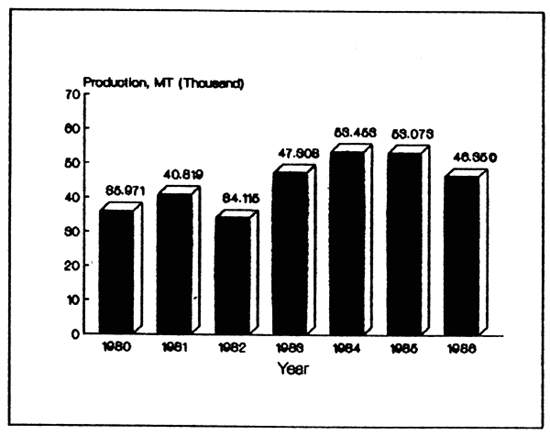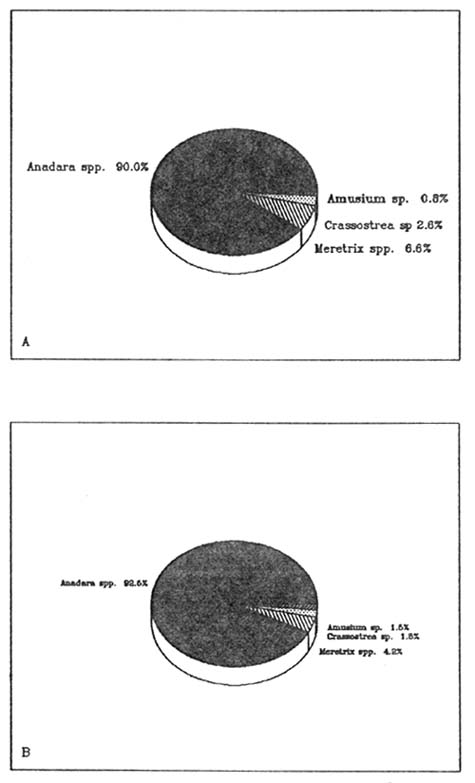The shellfish industry in Indonesia is certainly undeveloped
especially with regard to its aquaculture. The total bivalve
production in 1986 amounted to 46,350 MT of which the blood
cockle Anadara granosa (42,650 MT) accounted for 92%. The
landings of A. granosa have steadily increased from 32,383 MT in
1980 to 50,000 MT in 1985 although it dropped to 42,650 MT in
1986 (Table 1).
Other important bivalve species in Indonesia include hard clams
(Meretrix spp.), oysters (Crassostrea spp.) and scallop belonging
to the genus Amusium. Production of oysters fluctuated around
1,100 MT during the early 1980's, but only 800 MT was produced in
1986. Similarly, production of hard clams fluctuated around
2,500 MT in the first half of 1980 but only 2,000 MT was
reportedly produced in 1986. In contrast, scallop landings have
increased steadily from 166 MT in 1980 to 900 MT in 1986 with an
average annual growth rate of over 33%.
The total production figures of these species from 1980 to 1986
are shown in Figure 1. The production between 1980 and 1983
averaged roughly 37,000 MT whilst in 1985 it increased to 53,073
MT with an average annual growth rate of 13%.
Figure 2 shows the production values of the most important bivalve species cultured in Indonesia for the periods 1980–1983 and 1984–1986. The cumulative output during the second period increased for both the blood cockle and scallop, whereas both hard clam and oysters output decreased. The production percentages of the species indicated in Table 1 from their total production for the two periods are shown in Figure 3. Both cockle and scallop increased in total output, passing from 90.0% to 92.5% for cockle and from 0.8% to 1.5% for scallop in the period 1980–1983 and 1983–1986 respectively.
Table 2 summarizes a number of information on the status of bivalve culture in Indonesia. So far, shellfish culture in Indonesia has experienced a very slow advance mainly due to health hazards and consumer preferences. No sanitary control is imposed on collected bivalves. Although the great majority of capture and potential culture sites are pollution-free it is felt that some means of quality control should be developed to stimulate demand. As to consumer food preferences, seafood does not constitute the daily diet of all Indonesians; only a few regions of the country, such as south Sulawesi, Maluku and Irian Jaya give preference to seafood, whereas in the remaining regions vegetables are preferred to fish or meat. For these two reasons there is a low market demand for shellfish and little incentive to invest in shellfish culture. Other major constraints are the lack of trained personnel, statistics and location of suitable culture areas. For future development, pilot farms for cockle culture need to be introduced in cockle-collecting areas in order to maintain the natural stocks and sustain the already established cockle market. Promotion of mussel culture as an important animal protein resource is necessary. For oysters, suitable species for culture are being sought.
Table 1: Annual production of commercially important shellfish in Indonesia, 1980–1986. (Values: MT).
| SPECIES | YEAR | ||||||
|---|---|---|---|---|---|---|---|
| 1980 | 1981 | 1982 | 1983 | 1984 | 1985 | 1986 | |
| Crassostrea sp. | 1,141 | 1,131 | 1,016 | 1,041 | 1,198 | 744 | 800 |
| Anadara spp. | 32,383 | 37,410 | 29,335 | 43,250 | 48,802 | 50,000 | 42,650 |
| Meretrix spp. | 2,281 | 2,053 | 3,438 | 2,554 | 2,790 | 1,597 | 2,000 |
| Amusium sp. | 166 | 225 | 326 | 463 | 663 | 732 | 900 |

Figure 1. Total annual production of commercially important bivalves in Indonesia from 1980 to 1986.

Figure 2. Total production figures for the periods 1980–1983 and 1984–1986 of the major bivalve species in Indonesia.

Figure 3. Comparative production percentages of the major bivalve species cultured in Indonesia for the periods 1980–1983 (A) and 1984–1986 (B).
Table 2: Information on status of mollusc culture in Indonesia.
| INFORMATION REQUIRED | SPECIES | |||
|---|---|---|---|---|
| Crassostrea sp. | Anadara spp. | Meretrix spp. | Amusium sp. | |
| Source of seed | Wild | Wild | Wild | Wild |
| Culture method | Suspended Intertidal Bottom | Bottom | Bottom | Suspended |
| Yield/ha | NA | NA | NA | NA |
| Market | Domestic | Domestic | Domestic | Domestic |
| Production area | NA | NA | NA | NA |
| Status of culture | Experimental | Developed | Developing | Developing |
| Major constraints | - Lack of trained personnel - Poor quality control - Low demand | - Poor quality control | - Lack of trained personnel - Poor quality control - Low demand | - Lack of trained personnel - Poor quality control - Low demand |